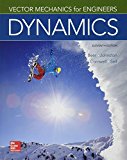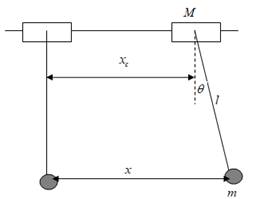
Concept explainers
(a)
The amplitude of the motion of bob
Answer to Problem 19.110P
The amplitude of motion of bob is
Explanation of Solution
Given:
Mass of bob is
Length of pendulum is
Mass of collar is
The relation of displacement is
The maximum amplitude of displacement is
Frequency is
Concept used:
Draw the diagram for system as shown below:

As the bob has a small displacement, from the above figure,
Here,
Write the expression for the force balance in initial condition.
Here,
Write the expression for Newton’s Law of motion in x-direction.
Substitute
Here,
Substitute
Substitute
Write the general differential equation of motion.
Here,
Compare equation (3) and (2).
Write the expression for the amplitude of forces vibration.
Here,
Calculation:
Substitute
Substitute
The amplitude of motion of bob is
Conclusion:
Thus, the amplitude of motion of bob is
(b)
The periodic force that should be applied to the collar to maintain periodic motion.
Answer to Problem 19.110P
The periodic force required to maintain the motion of collar is
Explanation of Solution
Concept used:
Draw the FBD of collar as shown below:

In the above Figure
Write the expression for Newton’s Law of motion in x-direction.
Substitute
Substitute
Substitute
Write the relation for
Differentiate the above expression with respect to
Differentiate the above expression with respect to
Substitute
Simplify the above expression for
`
Calculation:
Substitute
The periodic force required to maintain the motion of collar is
Conclusion:
Thus, the periodic force required to maintain the motion of collar is
Want to see more full solutions like this?
Chapter 19 Solutions
Package: Vector Mechanics For Engineers: Dynamics With 1 Semester Connect Access Card
- A 36-lb motor is bolted to a light horizontal beam that has a static deflection of 0.075 in. due to the weight of the motor. Knowing that the unbalance of the rotor is equivalent to a weight of 0.64 oz located 6.25 in. from the axis of rotation, determine the amplitude of the vibration of the motor at a speed of 900 rpm, assuming (a ) that no damping is present, (b ) that the damping factor c/cc is equal to 0.055.arrow_forwardA bungee jumper weighing 160 lb ties one end of an elastic rope with a length of 200 ft and stiffness of 10 lb/in in to a bridge and the other end to himself. If the man jumps off the bridge and assuming that the bridge is rigid, determine the amplitude of vibration. The initial position is zero and the initial velocity is 100 ft/sarrow_forwardA vibrometer used to measure the amplitude of vibrations consists essentially of a box containing a mass-spring system with a known natural frequency of 120 Hz. The box is rigidly attached to a surface that is moving according to the equation y= δm sin wf t. If the amplitude zm of the motion of the mass relative to the box is used as a measure of the amplitude δm of the vibration of the surface, determine (a) the percent error when the frequency of the vibration is 600 Hz,(b) the frequency at which the error is zero.arrow_forward
- A 400-kg motor supported by four springs, each of constant 150 kN/m, and a dashpot of constant c = 6500 N·s/m is constrained to move vertically. Knowing that the unbalance of the rotor is equivalent to a 23-g mass located at a distance of 100 mm from the axis of rotation, determine for a speed of 800 rpm (a ) the amplitude of the fluctuating force transmitted to the foundation, (b ) the amplitude of the vertical motion of the motor.arrow_forwardA spring-mass system K1, m, has a natural frequency of f1. If a second spring K2 is added in parallel with the first spring, the natural frequency is lowered to 1/2f1. Determine K2 in terms of K1.arrow_forwardA spring-mass-damper system has a mass of 80 kg suspended from a spring having stiffness of 1000 N/m and a viscous damper with a damping coefficient of 80 N-s/m. If the mass is subjected to a periodic disturbing force of 50 N at an undamped natural frequency, determine (i) The undamped natural frequency. (ii) The damped natural frequency. (iii) The amplitude of forced vibration of mass. (iv) The phase difference.arrow_forward
- A 91-kg machine element supported by four springs, each of constant k = 175 N/m, is subjected to a periodic force of frequency 0.8 Hz and amplitude 89 N. Determine the amplitude of the fluctuating force transmitted to the foundation if (a ) a dashpot with a coefficient of damping c=365 N.s/m is connected to the machine element and to the ground, (b) the dashpot is removed.arrow_forwardA bungee jumper weighing 160 lb ties one end of an elastic rope with a length of 200 ft and stiffness of 10 lb/in in to a bridge and the other end to himself. If the man jumps off the bridge and assuming that the bridge is rigid, determine the amplitude of vibration. The initial position is zero and the initial velocity is 100 ft/s. * 371.72 ft 530.85 ft 242.33 ft 491.23 ftarrow_forwardA sensitive electronic system, of mass 25 kg, is supported by a spring-damper isolator that rests on the floor of a manufacturing plant. The operation of nearby rotating equipment causes the floor to vibrate with an amplitude of 8 mm at a frequency of 35 Hz. The electronic system can only operate effectively if the amplitude of its acceleration is less than 40 m/s2. It is known that the damping ratio of the isolator is 0.1. i. Determine the maximum stiffness of the isolator needed for the transmitted acceleration level to be acceptable and hence facilitate effective operation of the electronic system. Using the calculated stiffness value, also determine the largest deformation of the spring in millimetres when the system is in motion. ii. If the damping ratio is allowed to increase by only increasing the equivalent damping coefficient (c) of the isolator, discuss the effect this change would have on the response of the electronic system when operating in the same environment. In your…arrow_forward
- Two springs of constants K1 and K2 are connected in series to a block A that vibrates in simple harmonic motion with a period of 5 s. When the same two springs are connected in parallel to the same block, the block vibrates with a period of 2 s. Determine the ratio K1/K2 of the two spring constants.arrow_forwardIn the case of the forced vibration of a system, determine the range of values of the damping factor c/cc for which the magnification factor will always decrease as the frequency ratio wf/wn increases.arrow_forwardA slender 10-kg bar AB with a length of l = 0.6 m is connected to two collars of negligible weight. Collar A is attached to a spring with a constant of k = 1.5 kN/m and can slide on a horizontal rod, while collar B can slide freely on a vertical rod. Knowing that the system is in equilibrium when bar AB is vertical and that collar A is given a small displacement and released, determine the period of the resulting vibrations.arrow_forward
 Elements Of ElectromagneticsMechanical EngineeringISBN:9780190698614Author:Sadiku, Matthew N. O.Publisher:Oxford University Press
Elements Of ElectromagneticsMechanical EngineeringISBN:9780190698614Author:Sadiku, Matthew N. O.Publisher:Oxford University Press Mechanics of Materials (10th Edition)Mechanical EngineeringISBN:9780134319650Author:Russell C. HibbelerPublisher:PEARSON
Mechanics of Materials (10th Edition)Mechanical EngineeringISBN:9780134319650Author:Russell C. HibbelerPublisher:PEARSON Thermodynamics: An Engineering ApproachMechanical EngineeringISBN:9781259822674Author:Yunus A. Cengel Dr., Michael A. BolesPublisher:McGraw-Hill Education
Thermodynamics: An Engineering ApproachMechanical EngineeringISBN:9781259822674Author:Yunus A. Cengel Dr., Michael A. BolesPublisher:McGraw-Hill Education Control Systems EngineeringMechanical EngineeringISBN:9781118170519Author:Norman S. NisePublisher:WILEY
Control Systems EngineeringMechanical EngineeringISBN:9781118170519Author:Norman S. NisePublisher:WILEY Mechanics of Materials (MindTap Course List)Mechanical EngineeringISBN:9781337093347Author:Barry J. Goodno, James M. GerePublisher:Cengage Learning
Mechanics of Materials (MindTap Course List)Mechanical EngineeringISBN:9781337093347Author:Barry J. Goodno, James M. GerePublisher:Cengage Learning Engineering Mechanics: StaticsMechanical EngineeringISBN:9781118807330Author:James L. Meriam, L. G. Kraige, J. N. BoltonPublisher:WILEY
Engineering Mechanics: StaticsMechanical EngineeringISBN:9781118807330Author:James L. Meriam, L. G. Kraige, J. N. BoltonPublisher:WILEY





